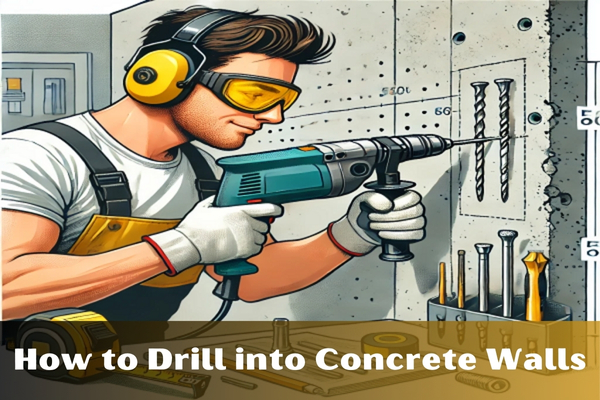Drilling into concrete walls is a common task for both DIY enthusiasts and professionals. Whether you’re mounting shelves, hanging pictures, or installing electrical fixtures, knowing how to properly drill into concrete is essential for achieving sturdy and reliable results. This comprehensive guide will walk you through the steps, tools, and tips necessary to drill into concrete walls efficiently and safely.
Understanding Concrete Walls
Before you start drilling, it’s important to understand the composition of concrete walls. Concrete is a durable material made from cement, aggregate (like gravel or sand), and water. This composition makes it incredibly hard and resistant to many types of physical impact, but also brittle and prone to cracking under certain conditions.

Tools and Materials Needed
To successfully drill into a concrete wall, you’ll need the following tools and materials:
- Hammer Drill: This is essential for drilling into concrete. A hammer drill differs from a regular drill by providing a hammering action as it rotates, making it easier to bore into hard materials.
- Masonry Drill Bits: These bits are specifically designed to cut through concrete and other masonry surfaces.
- Safety Gear: Safety goggles, gloves, and ear protection are crucial to protect yourself from flying debris and the noise of the drill.
- Tape Measure and Pencil: For marking the exact spots where you will drill.
- Anchors and Screws: Depending on your project, you may need wall anchors made for concrete.
- Dust Mask or Respirator: To avoid inhaling concrete dust, which can be harmful.
Step-by-Step Guide to Drilling into Concrete
Step 1: Preparing the Work Area
Ensure the area is clean and clear of any obstacles. Measure and mark the spots where you intend to drill. Use a pencil for visible marks that can be easily removed later.
Step 2: Safety First
Put on all necessary safety gear. The goggles will protect your eyes from dust and debris, the gloves will protect your hands, and ear protection is important since hammer drills are loud.
Step 3: Setting Up Your Drill
Fit your hammer drill with the appropriate masonry bit. Ensure the bit is securely attached. Set the drill to hammer mode if it has that option.
Step 4: Drilling the Hole
Align the drill bit with your mark on the wall. Start drilling at a slow speed to establish the hole, then increase the speed as the bit bites into the concrete. Apply steady pressure but let the drill do most of the work. Avoid pushing too hard as this can burn out the motor and wear out the bit.
Step 5: Blowing Out the Dust
Every few seconds, pull the drill bit out of the hole to remove dust. This ensures optimal performance of the drill bit and guards against excessive heat buildup. Once the hole is drilled to the desired depth, remove the drill and clear out any remaining dust with compressed air or a vacuum.
Installation of Anchors
For tasks that require hanging or mounting, you will likely need to install anchors:
- Select the Right Anchor: There are various types of concrete anchors, including expansion anchors, screw anchors, and adhesive anchors. Choose one that fits the weight and type of object you are hanging.
- Insert the Anchor: Place the anchor into the hole. For expansion anchors, you might need to gently hammer it in place.
- Secure the Fixture: Screw your fixture or item into the anchor. Ensure it is tight and secure.
You can also learn about Best Drill Bits For Concrete Lintels.
Conclusion
I hope, In this article, you have learned about how to drill into concrete walls. With the right tools, a bit of know-how, and proper safety precautions, you can undertake this task with confidence. Whether you’re a seasoned DIYer or a beginner, following these steps will help you securely mount or hang items on your concrete walls, ensuring a successful project from start to finish. Always remember to consult specific product instructions and local building codes to ensure compliance and safety.
By mastering the art of drilling into concrete, you not only enhance your DIY skills but also empower yourself to improve and beautify your living space. Remember, preparation and proper technique are key to success!
Thank You for the Reading!
FAQs:
Can I use a regular drill instead of a hammer drill to drill into concrete?
While it is technically possible, using a regular drill is much more difficult and time-consuming. A hammer drill is specifically designed for such tasks.
How do I know what size masonry bit to use?
To choose the correct size masonry bit, match the diameter of the bit to the size of the screws or anchors you will use. The packaging of these fasteners usually specifies the required bit size.
How deep should I drill into the wall?
Generally, you should drill at least 1/4 inch deeper than the length of your anchor. This allows space for dust and debris and ensures the anchor can expand properly.
Is it necessary to use anchors for every project?
For most projects involving concrete, yes. Concrete is too brittle to hold screws effectively without some form of anchor.
